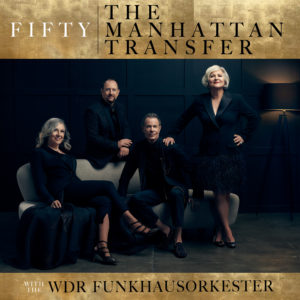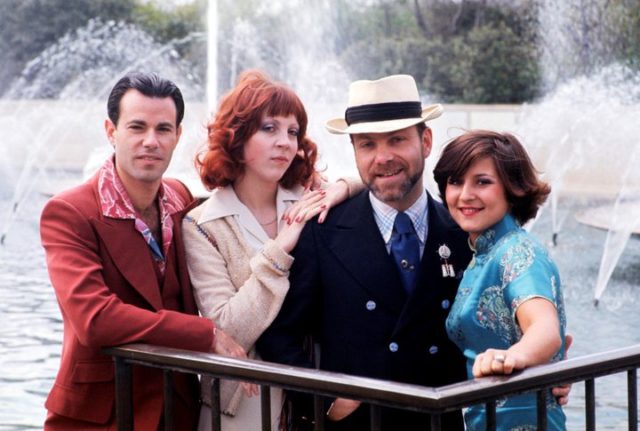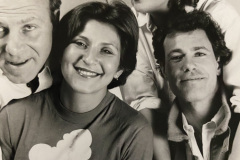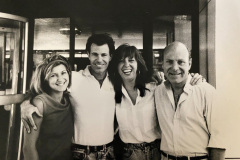The Story of the Manhattan Transfer
 Celebrating their 50th Anniversary, The Manhattan Transfer continues to set the standard as one of the world’s greatest and most innovative vocal bands. Winners of ten Grammy Awards, with millions of records sold worldwide, this amazing quartet is building upon the extraordinary legacy created by founder Tim Hauser who organized the four-part harmony group along with Janis Siegel (alto), Alan Paul (tenor), and Laurel Masse (soprano) on October 1, 1972. Cheryl Bentyne (soprano) replaced Masse in 1979, and Trist Curless (bass) replaced Tim Hauser following his passing on October 16, 2014.
Celebrating their 50th Anniversary, The Manhattan Transfer continues to set the standard as one of the world’s greatest and most innovative vocal bands. Winners of ten Grammy Awards, with millions of records sold worldwide, this amazing quartet is building upon the extraordinary legacy created by founder Tim Hauser who organized the four-part harmony group along with Janis Siegel (alto), Alan Paul (tenor), and Laurel Masse (soprano) on October 1, 1972. Cheryl Bentyne (soprano) replaced Masse in 1979, and Trist Curless (bass) replaced Tim Hauser following his passing on October 16, 2014.
Says Alan Paul. “It's astounding to me that the group has been able to create and share our musical harmony for five decades. It is truly a blessing.” Adds Siegel, “We are proud to still be here through all the changes. We stayed true to ourselves. What The Manhattan Transfer does on stage brings so much joy, sharing music we love.”
Defying categorization, The Manhattan Transfer became the first vocal group to win Grammy Awards in the pop and jazz categories in one year, 1981: Best Pop Performance by a Duo or Group with Vocal for “Boy From New York City” (a cover of the 1964 song by The Ad Libs), and Best Jazz Performance by a Duo or Group for “Until I Met You (Corner Pocket).”

“We were always very eclectic musically,” says Paul, “and we did not want to be limited or locked into one style of music. We wanted to make great records and believed that excellence existed in all genres of music. We have always had the freedom to explore and put our harmonic stamp on whatever we did.” Siegel emphasizes the group’s unmatched ability to excel performing a wide variety of music. “We didn’t say we were a pop group. We didn’t say we were a jazz group. We’re a vocal group.”
Beginning with their first performances in the early 1970’s, the members of the Vocal Group Hall of Fame have become cornerstones of contemporary music, known for their amazing versatility, incorporating pop, jazz, R&B, rock and roll, swing, symphonic, and a cappella music. The original group consisted of Hauser, Siegel, Paul, and Laurel Massé. After being signed by the legendary Ahmet Ertegun to Atlantic Records, The Manhattan Transfer made their recording debut with their self-titled album in 1975.
“It took a while to get a deal,” Paul remembers. “We were selling out clubs in New York City, but no one would sign us. The labels thought we were not commercial and didn’t want to take a risk.” Bette Midler was a friend of Tim’s and through her manager, Aaron Russo, invited Ahmet (Ertegun) to our show in Philly and the rest is history.”
Gallery: The 1970s
no images were found

In the early 1970’s, The Manhattan Transfer emerged out of the underground, avant-garde movement in New York City. The group wanted to visually interpret the music they were singing like chameleons, constantly changing their image to fit their musical styles. Their look ranged from heavy makeup and surreal Cockette’s inspired costumes to tuxedoes and tails. “We followed the philosophy of David Bowie,” states Paul. “Create a persona, and then destroy it to evolve into something else.”
Then known primarily as an east coast cult act, the group expanded their following by starring in their own 1975 CBS-TV variety series as a summer replacement for the Cher (Bono) Show. The Manhattan Transfer garnered international popularity when "Chanson D'Amour" from the 1976 Coming Out album became a surprise number one hit in Europe.

In their 50 years, the group has attained incredible longevity while navigating devastating obstacles. In 1978, a car accident caused Masse to leave the group. “We didn’t know if we’d be able to continue but Ahemt (Ertegun) encouraged us to find a replacement,” remembers Paul. “We auditioned ten singers for soprano. Cheryl Bentyne was the last one. After 12 bars we all knew she was the one. We brought out champagne and said, ‘You’re in.’”
Bentyne made her recording debut on the 1979 Extensions album which won two Grammys for their cover of Weather Report’s “Birdland” (with lyrics by Jon Hendricks): Best Jazz Fusion Performance, Vocal or Instrumental; and Siegel won for Best Arrangement for Voices. “It was mind blowing,” recalls Bentyne. “The group had never won a Grammy, had never been to the Grammys. We came up on a hydraulic lift at Radio City Music Hall. Michael Jackson, Madonna and Barry Manilow were watching us sitting in the front row.”
The new chapter of The Manhattan Transfer had become an instant success.
Gallery: The 1980s
no images were found

Siegel originated the concept to record a vocalized version of the Weather Report classic. “It was my idea of bring vocalese into the present. The Weather Report song sounded to me like a pop song of the future. Like a conversation between the instruments,” she recalls. “Working with Jon Hendricks on that song was the beginning of our close relationship.” (Hendricks later wrote lyrics for eight songs on their landmark 1985 Vocalese album.)
For Siegel, performing “Birdland” in 1979 at The Grammy Awards was one of her personal highlights, along with singing twice at The White House, and performing at President Bill Clinton’s inauguration in 1993 with Little Jimmy Scott. She says the group was blessed to know giants of the music business. “Working with Ahmet + Nesuhi Ertegun, Arif Mardin, Claude Nobs and Phil Carson was extraordinary,” she reflects. “We were fortunate to catch the tail end of a golden era in the music business.”
The Manhattan Transfer has also sung with many more “giants of the music business,” including Tony Bennett, Smokey Robinson, Bette Midler, Phil Collins, B.B. King, Chaka Khan, James Taylor, Laura Nyro, Ruth Brown, Boz Skaggs, Joe Zawinul, Stan Getz, James Moody, Dizzy Gillespie and Frankie Valli of The Four Seasons.

In 1985, The Manhattan Transfer’s Vocalese made history as the single greatest Jazz Grammy nominated album in history in one year with 12 nominations. “It was mind-boggling after the pop success we had,” says Paul. Vocalese, which featured jazz legends Dizzy Gillespie, Ron Carter, and the Count Basie Orchestra, changed the perception of The Manhattan Transfer. “Now we were accepted as jazz singers for the first time after being pop stars,” says Paul. Vocalese earned two more Grammys: Best Jazz Vocal Performance, Duo or Group; and Best Vocal Arrangement for Two Or More Voices for “Another Night in Tunisia” (won by Bentyne and Bobby McFerrin).
Another unforgettable highlight for the group was presenting and performing at the 1983 Grammy Awards with Ella Fitzgerald. “That was probably the peak,” comments Paul. “We were at the podium singing ‘How High the Moon,” says Bentyne. “The Grammys had never heard anything like that.” For Siegel, it was extra special because Fitzgerald is her idol. “At the rehearsals we were going over the song. We sang, she scatted. And she said, ‘Was that all right?’ In awe of the legendary singer’s breathtaking performance, Siegel told her, “Of course, you’re Ella Fitzgerald.”
Gallery: The 1990s
The “high” of singing with Fitzgerald at The Grammys, was later contrasted with another nearly overwhelming low that tested the resilience of The Manhattan Transfer. In 2011, Bentyne had to temporarily leave the group while undergoing treatment for Hodgkin’s lymphoma. Margaret Dorn replaced her then, and again in December 2013 while Bentyne underwent further treatment. “I was out with cancer for 8 months in 2011, and the cancer came back in 2013,” says Bentyne. “I had stem cell transplant with all new cells. At the same time, Tim was very ill, and Trist (Curless) took his place. The group had to work doubly hard in my absence and Tim’s absence. We had a lot of bumps to overcome.”
In 2013, Hauser underwent spinal surgery and was replaced by Curless of the Los Angeles a cappella group, M-pact. In 2014, following the passing of Hauser, Curless became an official member of the group, forming the third incarnation of The Manhattan Transfer. Now the group is dedicated to maintaining and building upon the legacy of the late Hauser.
“It has taken us a while to recover,” says Siegel. “Tim (Hauser) was a dear friend and the guiding light of the group. There would not be The Manhattan Transfer without Tim Hauser. He was the passionate driving force and one of the most creatively generous people I ever met. He was a musical historian. I learned so much from him about music.” Siegel remembers the shock of his passing. “Tim got seriously ill on the road in the middle of a tour, and then never recovered. The grieving was a long process. We thought we might end the group. However, we realized people all over the world wanted the music to continue.”
“It was extremely difficult,” Paul remembers. “He was my brother. A great loss. We spent the whole year doing a memorial tour for him. The fans supported us. Trist Curless subbed for him. We are very grateful for the fans support who warmly accepted Trist. We had to continue the legacy,” he adds. “Our fans embraced us. If we did not have our fans, we could not go on. We would cry onstage. We would not have been able to do it without our fans support.”
“Tim was my mentor, the professor, the guiding light,” comments Bentyne. “He was the energy of the group. He was older, but we couldn’t keep up with him. He was the spark for music. He was amazing.” Bentyne was especially grateful for how Hauser made her feel comfortable as a new member of the group. “He was always helping me fitting in. I was intimated at first singing in the studio. He took time with me and helped me get through it.” Bentyne fondly remembers Hauser’s loving reaction when she was honored in 1985. “When I won a Grammy (Best Vocal Arrangement For Two Or More Voices) with Bobby McFerrin for “Another Night in Tunisia,” Tim had tears in his eyes for me. He said, ‘I’m so proud of you.’”
Gallery: The 2000s
no images were found
As The Manhattan Transfer performed with their current lineup, they’re returned to the road for a very special collaboration, joining Take 6 on The Summit Tour across the United States from October 2016 through March 2017. “To be on stage with them is glorious,” says Siegel. “They are all phenomenal people and singers. It is a challenge putting together a show for ten singers. It has been been a great experience, them singing our songs, and vice versa. It has been ten singers having a blast.” “We have been fans of each other for a long time,” adds Paul.
Curless, who worked as an audio engineer for several acts, including Take 6, in addition to leading his a cappella group M-pact, is extremely proud and honored to join Paul, Siegel, and Bentyne in enhancing their rich legacy. “It is a privilege and an honor to help The Manhattan Transfer celebrate 45 years and helping it continue. I am excited to help carry on the tradition of harmony singing with the new album and spread it further. For Curless, joining The Manhattan Transfer goes beyond what he could have dreamed of. “As a young singer into group singing, I listened to the Manhattan Transfer. Such an influence helping me to grow. One of my favorite groups.”
Looking to the future of The Manhattan Transfer, Paul says, “I am excited about creating new music. We are thrilled to have Trist in the group as we venture forward. He is a solid scat singer and his rich bass adds a whole new texture to our sound.” “This new chapter is exciting. I'm exhilarated about what we will come up with next,” comments Siegel. “It will be intriguing to see Trist’s influences. He brings great energy. We found a wonderful partner in Trist.” Siegel is also proud of The Manhattan Transfer’s role as a trailblazer and trendsetter. “It is gratifying to see so many vocal groups, especially a cappella groups,” she states. “If we promoted any of that, we are happy.” Bentyne adds, “Trist Curless really revitalized us, and brought a new energy which rises the group to another level.”
With Concord/Craft Recordings, the group’s new recording, FIFTY, featuring the WDR Funkhausorkester, celebrates a landmark year sharing where they are in their musical journey and an unparalleled career. The Manhattan Transfer continues to raise the bar, and set even higher standards.
Gallery: Friends
no images were found



